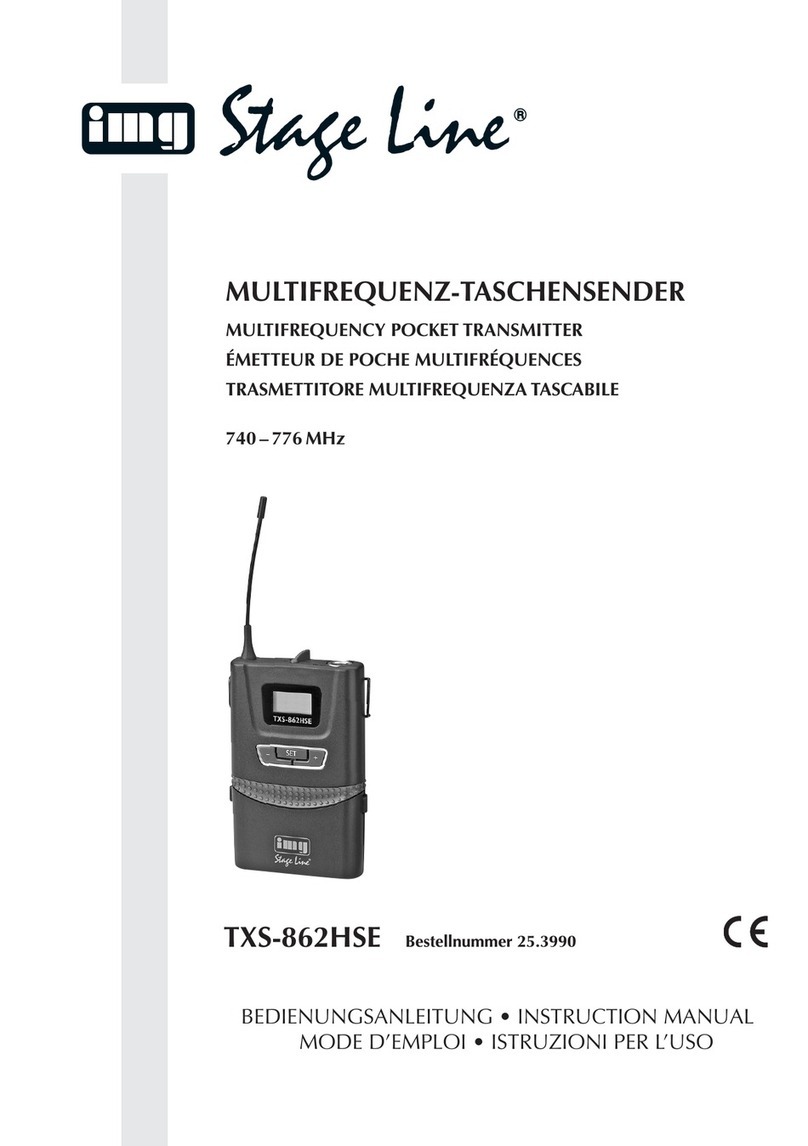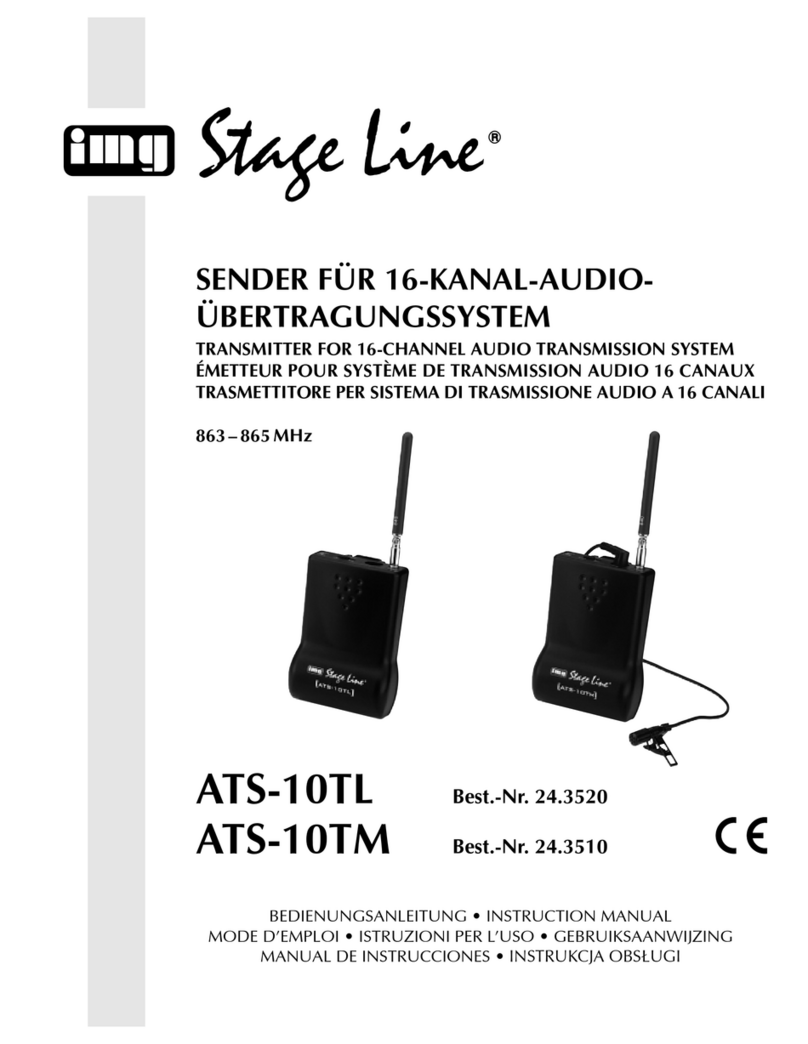9
GEn cas de non utilisation prolongée de lʼémetteur de
poche, retirez les batteries ; elles pourraient couler
et lʼendommager.
Pour ouvrir le compartiment batterie (9), appuyez sur
la flèche du couvercle du compartiment batterie (5) et
poussez le couvercle vers le bas.
Insérez les batteries en respectant les pôles plus et
moins comme indiqué sur le schéma 2 et refermez le
compartiment batterie.
4.2 Allumage de lʼémetteur
Informations sur lʼaffichage
Pour allumer, poussez lʼinterrupteur (2) sur la position
ON. (En position médiane STDBY, lʼémetteur fonctionne
mais le signal micro est coupé). Lʼéclairage dʼarrière-
plan de lʼaffichage (3) brille pendant quelques secondes.
Lʼaffichage indique les informations suivantes :
1. le groupe de canaux (GROUP 00 – 09)
2. le canal (CHANNEL 00 – 99)
3. lʼétat des batteries
plein vide
Si BATT clignote, remplacez les batteries.
Effectuez les réglages décrits dans les chapitres sui-
vants.
Après le fonctionnement, nʼoubliez pas dʼéteindre
lʼémetteur pour ne pas décharger les batteries.
4.3 Réglage du canal de transmission
1) Réglez tout dʼabord un canal de transmission libre
sur le récepteur (voir notice dʼutilisation du récep-
teur).
2) Maintenez le capteur infrarouge (4) de lʼémetteur
vers la fenêtre infrarouge sur le récepteur. La dis-
tance ne doit pas dépasser 1,5 m, il ne doit pas y
avoir dʼobstacle entre le capteur et la fenêtre infra-
rouge.
3) Sur le récepteur, appuyez brièvement sur la touche
ACT. Lʼéclairage de lʼarrière-plan de lʼaffichage de
lʼémetteur de poche brille et lʼémetteur est ainsi
réglé sur le même groupe de canaux et le même
canal que le récepteur (voir indication sur lʼaffi-
chage). Vous trouverez dans le tableau page 16/17,
les fréquences correspondantes aux canaux.
4.4 Branchements et fixation du microphone
cravate et de lʼémetteur de poche
1) Reliez la fiche (12) du microphone cravate à la prise
jack (6) de lʼémetteur. Pour éviter que la fiche ne soit
retirée, vissez la collerette de fixation (11) sur la prise.
2) Fixez le microphone cravate sur le vêtement, le
plus près possible de la bouche.
3) Une fois lʼamplification du signal micro réglée (cha-
pitre 4.5), fixez lʼémetteur sur le vêtement à lʼaide
de la pince (7) [par exemple ceinture].
4.5 Réglage de lʼamplification du signal micro
1) Allumez lʼappareil audio (par exemple table de
mixage, amplificateur) relié au récepteur. Parlez/
chantez dans le micro et réglez le volume de lʼins-
tallation audio de telle sorte que le réglage suivant
soit bien audible.
2) Réglez lʼamplification du signal micro avec le
réglage GAIN (8) situé sur la face arrière : si le
signal micro est trop fort et distordu, tournez le
réglage en arrière avec un petit tournevis. Si le
signal a un volume trop bas, le rapport signal sur
bruit est mauvais ; tournez alors le réglage en
conséquence dans lʼautre sens.
5 Caractéristiques techniques
Fréquence porteuse : . . . . 672,000 – 696,975 MHz
Canaux, voir tableau
pages 16+17
Stabilité de fréquences : . . ±0,005 %
Puissance dʼémission
(EIRP) : . . . . . . . . . . . . . . . 10 mW
Plage de fréquences audio : 30 – 18 000 Hz, ±3 dB
Alimentation : . . . . . . . . . . 2 × batterie 1,5 V,
type R6
Durée de fonctionnement : > 8 h
Température fonc. : . . . . . . 0 – 40 °C
Dimensions : . . . . . . . . . . . 61 mm × 106 mm × 27 mm
Poids : . . . . . . . . . . . . . . . . 125 g
Tout droit de modification réservé.
Ne jetez pas les batteries usagées et les accu-
mulateurs défectueux dans la poubelle domes-
tique ; déposez-les dans un container spéci-
fique ou ramenez-les à votre détaillant pour
contribuer à leur élimination non polluante.
F
B
CH
Notice dʼutilisation protégée par le copyright de MONACOR ®
INTERNATIONAL GmbH & Co. KG. Toute reproduction même par-
tielle à des fins commerciales est interdite.





























